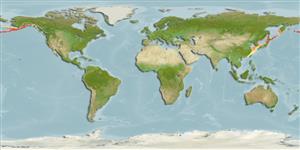Pycnogonida |
Pantopoda |
Ammotheidae
Environment: milieu / climate zone / depth range / distribution range
Ecology
Benthic. Subtropical
Pacific Ocean: Alaska (Ref. 2153), Korea Republic and USA (Ref. 12).
Length at first maturity / Size / Weight / Age
Maturity: Lm ? range ? - ? cm
Extremely setose/spinose species. Trunk circular in dorsal view, with 4 to 5 short median spines or sometimes spines lacking. Lateral processes contiguous, with many laterodistal setae continuing laterally on all first coxae, also with slender paired dorsodistal tubercles with spines at their tips. Ocular tubercle moderately long, eyes prominent. Proboscis slightly inflated, ovoid. Abdomen very long, with long paired dorsal spines. Palp segments short, second slightly longer than fourth, all with few dorsal setae and few ventral setae on distal 5 segments. Chelifores with many setae on scapes, most longer than segment diameter, and several short dorsal tubercles each with spine. Chela fingers atrophied, with single spine. Oviger with 3 to 4 rows of short spines on major segments, 4 strigilis segments with paired denticulate spines. Leg tibiae with many long dorsal setae, some originating on low tubercles, femur with few similar lateral and ventral setae. Second coxae of posterior 2 pairs of legs with genital spur slightly longer than segment diameter. Femur with dorsodistal tubercle as long as segment diameter, tubercle bearing tiny cement gland tube laterally near tip. Propodus slender, well curved, with 3 major heel spines, 8 to10 very small sole spines, and several lateral and dorsal setae. Claw long, little curved, auxiliaries slender, about 0.6 the main claw length (Ref. 2153, p. 3).
Shelf (Ref. 19).
Life cycle and mating behavior
Maturity | Reproduction | Spawning | Eggs | Fecundity | Larvae
Members of the class Pycnogonida are gonochoric and sexually dimorphic. During copulation, male usually suspends itself beneath the female. Fertilization occurs as the eggs leave the female's ovigers. Males brood the egg masses until they hatch. Life cycle: Eggs hatch into protonymphon larva then to adults.
King, P.E. 1973 Pycnogonids. Hutchinson of London. London, UK. 144 p. (Ref. 12)
IUCN Red List Status
(Ref. 130435: Version 2025-1)
CITES status (Ref. 108899)
Not Evaluated
Not Evaluated
Threat to humans
Human uses
| FishSource |
Tools
More information
Trophic EcologyFood items (preys)
Diet composition
Food consumption
Predators
Population dynamicsGrowth
Max. ages / sizes
Length-weight rel.
Length-length rel.
Length-frequencies
Mass conversion
Abundance
Life cycleReproductionMaturityFecunditySpawningEggsEgg developmentLarvae PhysiologyOxygen consumption
Human RelatedStamps, coins, misc.
Internet sources
Estimates based on models
Preferred temperature
(Ref.
115969): 3.9 - 4.5, mean 4 (based on 7 cells).
Price category
Unknown.
